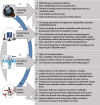Telehealth for COVID-19: A Conceptual Framework
- PMID: 36818384
- PMCID: PMC9929206
- DOI: 10.1155/2023/3679829
Telehealth for COVID-19: A Conceptual Framework
Retraction in
-
Retracted: Telehealth for COVID-19: A Conceptual Framework.J Healthc Eng. 2023 Nov 29;2023:9795327. doi: 10.1155/2023/9795327. eCollection 2023. J Healthc Eng. 2023. PMID: 38078185 Free PMC article.
Abstract
The world has been going through the global crisis of the coronavirus (COVID-19). It is a challenging situation for every country to tackle its healthcare system. COVID-19 spreads through physical contact with COVID-positive patients and causes potential damage to the country's health and economy system. Therefore, to overcome the chance of spreading the disease, the only preventive measure is to maintain social distancing. In this vulnerable situation, virtual resources have been utilized in order to maintain social distance, i.e., the telehealth system has been proposed and developed to access healthcare services remotely and manage people's health conditions. The telehealth system could become a regular part of our healthcare system, and during any calamity or natural disaster, it could be used as an emergency response to deal with the catastrophe. For this purpose, we proposed a conceptual telehealth framework in response to COVID-19. We focused on identifying critical issues concerning the use of telehealth in healthcare setups. Furthermore, the factors influencing the implementation of the telehealth system have been explored in detail. The proposed telehealth system utilizes artificial intelligence and data science to regulate and maintain the system efficiently. Before implementing the telehealth system, it is required that prearrangements be made, such as appropriate funding measures, the skills to know technological usage, training sessions, and staff endorsement. The barriers and influencing factors provided in this article can be helpful for future developments in telehealth systems and for making fruitful progress in fighting pandemics like COVID-19. At the same time, the same approach can be used to save the lives of many frontline workers.
Copyright © 2023 Waqas Yousaf et al.
Conflict of interest statement
The authors declare that they have no conflicts of interest.
Figures



Similar articles
-
Designing Futuristic Telemedicine Using Artificial Intelligence and Robotics in the COVID-19 Era.Front Public Health. 2020 Nov 2;8:556789. doi: 10.3389/fpubh.2020.556789. eCollection 2020. Front Public Health. 2020. PMID: 33224912 Free PMC article.
-
REVISITING HEALTH INFORMATION TECHNOLOGY ETHICAL, LEGAL, and SOCIAL ISSUES and EVALUATION: TELEHEALTH/TELEMEDICINE and COVID-19.Int J Med Inform. 2020 Nov;143:104239. doi: 10.1016/j.ijmedinf.2020.104239. Epub 2020 Jul 31. Int J Med Inform. 2020. PMID: 33152653 Free PMC article. Review.
-
Telehealth in school-based practice: Perceived viability to bridge global OT practitioner shortages prior to COVID-19 global health emergency.Work. 2020;67(1):29-35. doi: 10.3233/WOR-203240. Work. 2020. PMID: 32925151
-
Telehealth for global emergencies: Implications for coronavirus disease 2019 (COVID-19).J Telemed Telecare. 2020 Jun;26(5):309-313. doi: 10.1177/1357633X20916567. Epub 2020 Mar 20. J Telemed Telecare. 2020. PMID: 32196391 Free PMC article.
-
Applications, benefits and challenges of telehealth in India during COVID-19 pandemic and beyond: a systematic review.BMC Health Serv Res. 2023 Jan 4;23(1):7. doi: 10.1186/s12913-022-08970-8. BMC Health Serv Res. 2023. PMID: 36597088 Free PMC article.
Cited by
-
Retracted: Telehealth for COVID-19: A Conceptual Framework.J Healthc Eng. 2023 Nov 29;2023:9795327. doi: 10.1155/2023/9795327. eCollection 2023. J Healthc Eng. 2023. PMID: 38078185 Free PMC article.
-
TumorDetNet: A unified deep learning model for brain tumor detection and classification.PLoS One. 2023 Sep 27;18(9):e0291200. doi: 10.1371/journal.pone.0291200. eCollection 2023. PLoS One. 2023. PMID: 37756305 Free PMC article.
-
An effective approach for plant leaf diseases classification based on a novel DeepPlantNet deep learning model.Front Plant Sci. 2023 Oct 11;14:1212747. doi: 10.3389/fpls.2023.1212747. eCollection 2023. Front Plant Sci. 2023. PMID: 37900756 Free PMC article.
-
Human Factors and Organizational Issues in Health Informatics: Review of Recent Developments and Advances.Yearb Med Inform. 2024 Aug;33(1):196-209. doi: 10.1055/s-0044-1800744. Epub 2025 Apr 8. Yearb Med Inform. 2024. PMID: 40199306 Free PMC article. Review.
References
-
- Leite H., Gruber T., Hodgkinson I. R. Flattening the infection curve–understanding the role of telehealth in managing covid-19. Leadership in Health Services . 2019;33
Publication types
MeSH terms
LinkOut - more resources
Full Text Sources
Medical

